Analysis of Research Methods for Parkinson's Disease and Postural Sway
VerifiedAdded on 2020/12/09
|18
|6319
|146
Report
AI Summary
This report delves into the research methodologies employed in the study of Parkinson's disease, with a specific focus on the assessment of postural sway and balance. The introduction provides a historical overview of the disease, its symptoms, and diagnostic challenges, including motor and non-motor symptoms. The background section explores the unknown causes of Parkinson's, the role of dopamine, and the effectiveness of treatments like levodopa, as well as the Hoehn-Yahr scale. The discussion section examines potential research methodologies, highlighting the importance of understanding postural sway to mitigate complications such as falls and related injuries, as well as the ethical considerations that must be taken into account. The report discusses both quantitative and qualitative research approaches. The report underscores the need for a comprehensive understanding of the disease to improve patient outcomes, reduce healthcare costs, and enhance the overall quality of life for those affected by Parkinson's disease. The report concludes by emphasizing the importance of choosing the right research approach, highlighting the significance of body sway in preventing potential complications and risks associated with the disease.

Research Methods Module
Paraphrase This Document
Need a fresh take? Get an instant paraphrase of this document with our AI Paraphraser
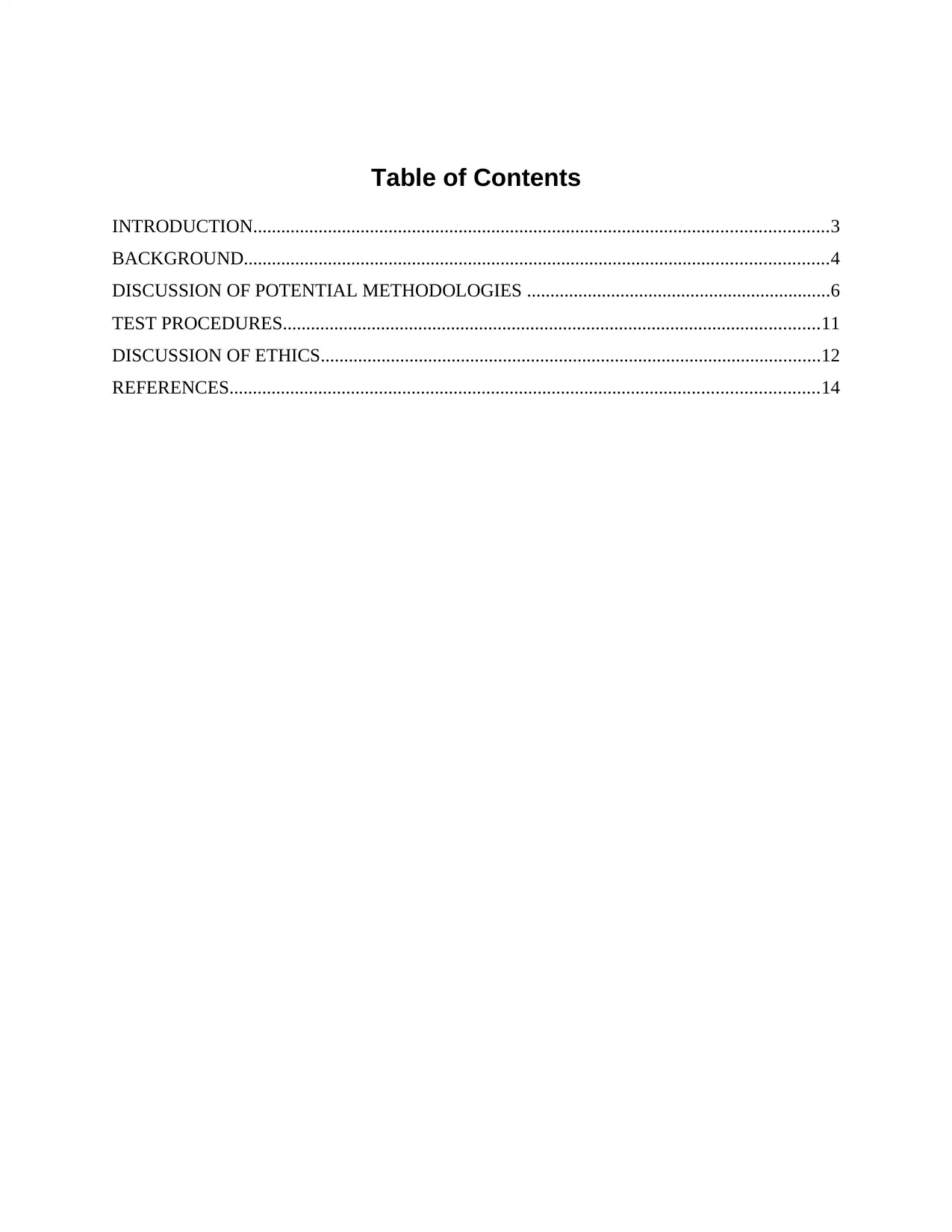
Table of Contents
INTRODUCTION...........................................................................................................................3
BACKGROUND.............................................................................................................................4
DISCUSSION OF POTENTIAL METHODOLOGIES .................................................................6
TEST PROCEDURES...................................................................................................................11
DISCUSSION OF ETHICS...........................................................................................................12
REFERENCES..............................................................................................................................14
INTRODUCTION...........................................................................................................................3
BACKGROUND.............................................................................................................................4
DISCUSSION OF POTENTIAL METHODOLOGIES .................................................................6
TEST PROCEDURES...................................................................................................................11
DISCUSSION OF ETHICS...........................................................................................................12
REFERENCES..............................................................................................................................14
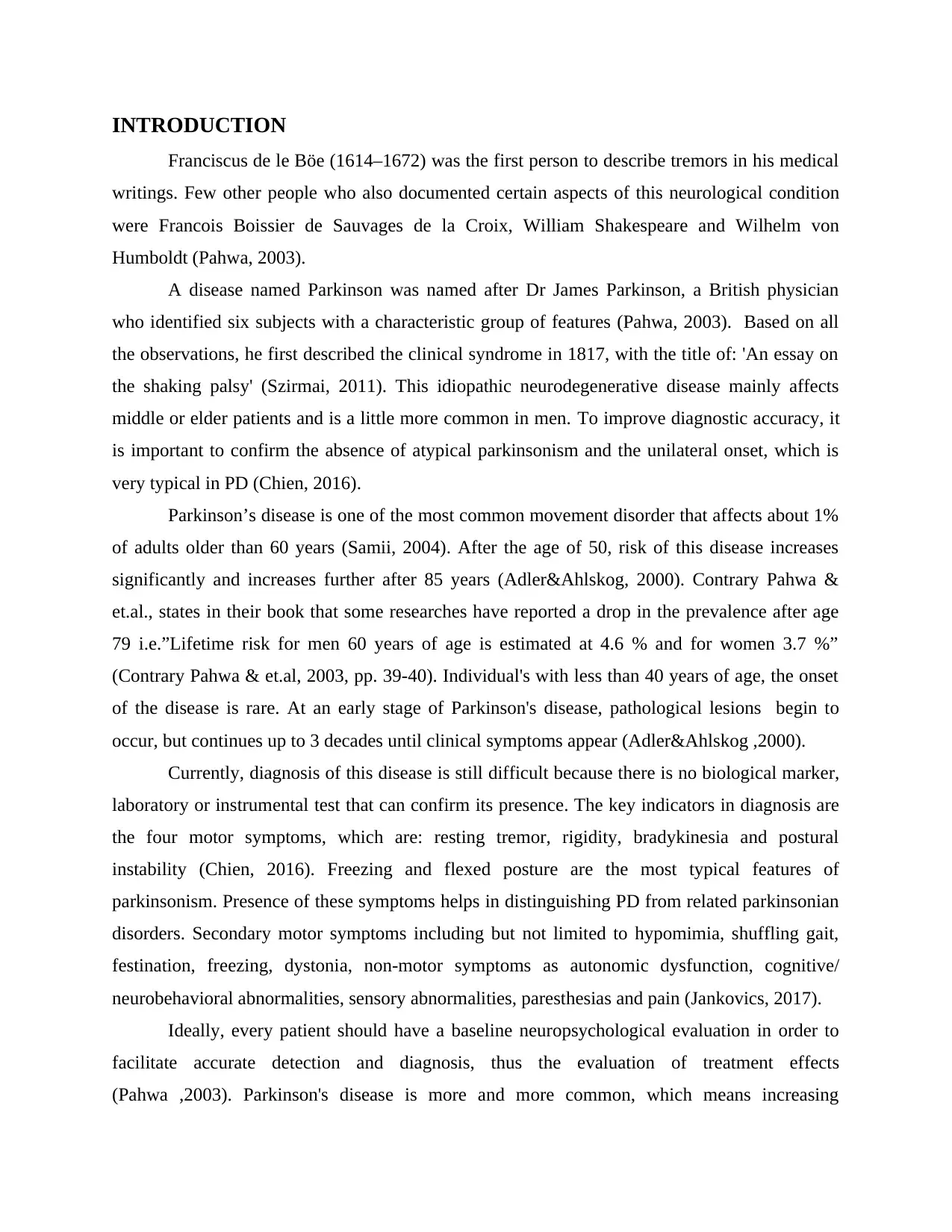
INTRODUCTION
Franciscus de le Böe (1614–1672) was the first person to describe tremors in his medical
writings. Few other people who also documented certain aspects of this neurological condition
were Francois Boissier de Sauvages de la Croix, William Shakespeare and Wilhelm von
Humboldt (Pahwa, 2003).
A disease named Parkinson was named after Dr James Parkinson, a British physician
who identified six subjects with a characteristic group of features (Pahwa, 2003). Based on all
the observations, he first described the clinical syndrome in 1817, with the title of: 'An essay on
the shaking palsy' (Szirmai, 2011). This idiopathic neurodegenerative disease mainly affects
middle or elder patients and is a little more common in men. To improve diagnostic accuracy, it
is important to confirm the absence of atypical parkinsonism and the unilateral onset, which is
very typical in PD (Chien, 2016).
Parkinson’s disease is one of the most common movement disorder that affects about 1%
of adults older than 60 years (Samii, 2004). After the age of 50, risk of this disease increases
significantly and increases further after 85 years (Adler&Ahlskog, 2000). Contrary Pahwa &
et.al., states in their book that some researches have reported a drop in the prevalence after age
79 i.e.”Lifetime risk for men 60 years of age is estimated at 4.6 % and for women 3.7 %”
(Contrary Pahwa & et.al, 2003, pp. 39-40). Individual's with less than 40 years of age, the onset
of the disease is rare. At an early stage of Parkinson's disease, pathological lesions begin to
occur, but continues up to 3 decades until clinical symptoms appear (Adler&Ahlskog ,2000).
Currently, diagnosis of this disease is still difficult because there is no biological marker,
laboratory or instrumental test that can confirm its presence. The key indicators in diagnosis are
the four motor symptoms, which are: resting tremor, rigidity, bradykinesia and postural
instability (Chien, 2016). Freezing and flexed posture are the most typical features of
parkinsonism. Presence of these symptoms helps in distinguishing PD from related parkinsonian
disorders. Secondary motor symptoms including but not limited to hypomimia, shuffling gait,
festination, freezing, dystonia, non-motor symptoms as autonomic dysfunction, cognitive/
neurobehavioral abnormalities, sensory abnormalities, paresthesias and pain (Jankovics, 2017).
Ideally, every patient should have a baseline neuropsychological evaluation in order to
facilitate accurate detection and diagnosis, thus the evaluation of treatment effects
(Pahwa ,2003). Parkinson's disease is more and more common, which means increasing
Franciscus de le Böe (1614–1672) was the first person to describe tremors in his medical
writings. Few other people who also documented certain aspects of this neurological condition
were Francois Boissier de Sauvages de la Croix, William Shakespeare and Wilhelm von
Humboldt (Pahwa, 2003).
A disease named Parkinson was named after Dr James Parkinson, a British physician
who identified six subjects with a characteristic group of features (Pahwa, 2003). Based on all
the observations, he first described the clinical syndrome in 1817, with the title of: 'An essay on
the shaking palsy' (Szirmai, 2011). This idiopathic neurodegenerative disease mainly affects
middle or elder patients and is a little more common in men. To improve diagnostic accuracy, it
is important to confirm the absence of atypical parkinsonism and the unilateral onset, which is
very typical in PD (Chien, 2016).
Parkinson’s disease is one of the most common movement disorder that affects about 1%
of adults older than 60 years (Samii, 2004). After the age of 50, risk of this disease increases
significantly and increases further after 85 years (Adler&Ahlskog, 2000). Contrary Pahwa &
et.al., states in their book that some researches have reported a drop in the prevalence after age
79 i.e.”Lifetime risk for men 60 years of age is estimated at 4.6 % and for women 3.7 %”
(Contrary Pahwa & et.al, 2003, pp. 39-40). Individual's with less than 40 years of age, the onset
of the disease is rare. At an early stage of Parkinson's disease, pathological lesions begin to
occur, but continues up to 3 decades until clinical symptoms appear (Adler&Ahlskog ,2000).
Currently, diagnosis of this disease is still difficult because there is no biological marker,
laboratory or instrumental test that can confirm its presence. The key indicators in diagnosis are
the four motor symptoms, which are: resting tremor, rigidity, bradykinesia and postural
instability (Chien, 2016). Freezing and flexed posture are the most typical features of
parkinsonism. Presence of these symptoms helps in distinguishing PD from related parkinsonian
disorders. Secondary motor symptoms including but not limited to hypomimia, shuffling gait,
festination, freezing, dystonia, non-motor symptoms as autonomic dysfunction, cognitive/
neurobehavioral abnormalities, sensory abnormalities, paresthesias and pain (Jankovics, 2017).
Ideally, every patient should have a baseline neuropsychological evaluation in order to
facilitate accurate detection and diagnosis, thus the evaluation of treatment effects
(Pahwa ,2003). Parkinson's disease is more and more common, which means increasing
⊘ This is a preview!⊘
Do you want full access?
Subscribe today to unlock all pages.

Trusted by 1+ million students worldwide
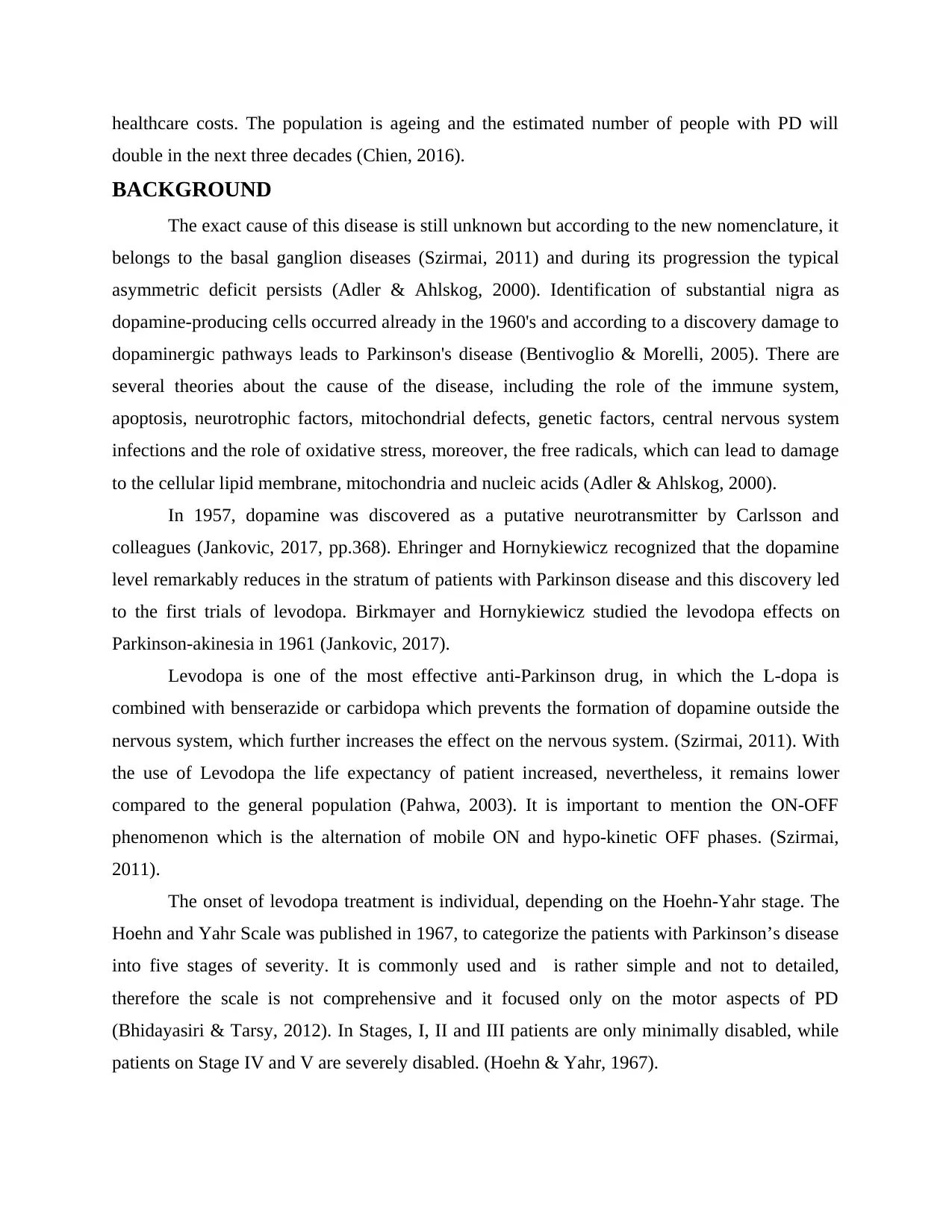
healthcare costs. The population is ageing and the estimated number of people with PD will
double in the next three decades (Chien, 2016).
BACKGROUND
The exact cause of this disease is still unknown but according to the new nomenclature, it
belongs to the basal ganglion diseases (Szirmai, 2011) and during its progression the typical
asymmetric deficit persists (Adler & Ahlskog, 2000). Identification of substantial nigra as
dopamine-producing cells occurred already in the 1960's and according to a discovery damage to
dopaminergic pathways leads to Parkinson's disease (Bentivoglio & Morelli, 2005). There are
several theories about the cause of the disease, including the role of the immune system,
apoptosis, neurotrophic factors, mitochondrial defects, genetic factors, central nervous system
infections and the role of oxidative stress, moreover, the free radicals, which can lead to damage
to the cellular lipid membrane, mitochondria and nucleic acids (Adler & Ahlskog, 2000).
In 1957, dopamine was discovered as a putative neurotransmitter by Carlsson and
colleagues (Jankovic, 2017, pp.368). Ehringer and Hornykiewicz recognized that the dopamine
level remarkably reduces in the stratum of patients with Parkinson disease and this discovery led
to the first trials of levodopa. Birkmayer and Hornykiewicz studied the levodopa effects on
Parkinson-akinesia in 1961 (Jankovic, 2017).
Levodopa is one of the most effective anti-Parkinson drug, in which the L-dopa is
combined with benserazide or carbidopa which prevents the formation of dopamine outside the
nervous system, which further increases the effect on the nervous system. (Szirmai, 2011). With
the use of Levodopa the life expectancy of patient increased, nevertheless, it remains lower
compared to the general population (Pahwa, 2003). It is important to mention the ON-OFF
phenomenon which is the alternation of mobile ON and hypo-kinetic OFF phases. (Szirmai,
2011).
The onset of levodopa treatment is individual, depending on the Hoehn-Yahr stage. The
Hoehn and Yahr Scale was published in 1967, to categorize the patients with Parkinson’s disease
into five stages of severity. It is commonly used and is rather simple and not to detailed,
therefore the scale is not comprehensive and it focused only on the motor aspects of PD
(Bhidayasiri & Tarsy, 2012). In Stages, I, II and III patients are only minimally disabled, while
patients on Stage IV and V are severely disabled. (Hoehn & Yahr, 1967).
double in the next three decades (Chien, 2016).
BACKGROUND
The exact cause of this disease is still unknown but according to the new nomenclature, it
belongs to the basal ganglion diseases (Szirmai, 2011) and during its progression the typical
asymmetric deficit persists (Adler & Ahlskog, 2000). Identification of substantial nigra as
dopamine-producing cells occurred already in the 1960's and according to a discovery damage to
dopaminergic pathways leads to Parkinson's disease (Bentivoglio & Morelli, 2005). There are
several theories about the cause of the disease, including the role of the immune system,
apoptosis, neurotrophic factors, mitochondrial defects, genetic factors, central nervous system
infections and the role of oxidative stress, moreover, the free radicals, which can lead to damage
to the cellular lipid membrane, mitochondria and nucleic acids (Adler & Ahlskog, 2000).
In 1957, dopamine was discovered as a putative neurotransmitter by Carlsson and
colleagues (Jankovic, 2017, pp.368). Ehringer and Hornykiewicz recognized that the dopamine
level remarkably reduces in the stratum of patients with Parkinson disease and this discovery led
to the first trials of levodopa. Birkmayer and Hornykiewicz studied the levodopa effects on
Parkinson-akinesia in 1961 (Jankovic, 2017).
Levodopa is one of the most effective anti-Parkinson drug, in which the L-dopa is
combined with benserazide or carbidopa which prevents the formation of dopamine outside the
nervous system, which further increases the effect on the nervous system. (Szirmai, 2011). With
the use of Levodopa the life expectancy of patient increased, nevertheless, it remains lower
compared to the general population (Pahwa, 2003). It is important to mention the ON-OFF
phenomenon which is the alternation of mobile ON and hypo-kinetic OFF phases. (Szirmai,
2011).
The onset of levodopa treatment is individual, depending on the Hoehn-Yahr stage. The
Hoehn and Yahr Scale was published in 1967, to categorize the patients with Parkinson’s disease
into five stages of severity. It is commonly used and is rather simple and not to detailed,
therefore the scale is not comprehensive and it focused only on the motor aspects of PD
(Bhidayasiri & Tarsy, 2012). In Stages, I, II and III patients are only minimally disabled, while
patients on Stage IV and V are severely disabled. (Hoehn & Yahr, 1967).
Paraphrase This Document
Need a fresh take? Get an instant paraphrase of this document with our AI Paraphraser
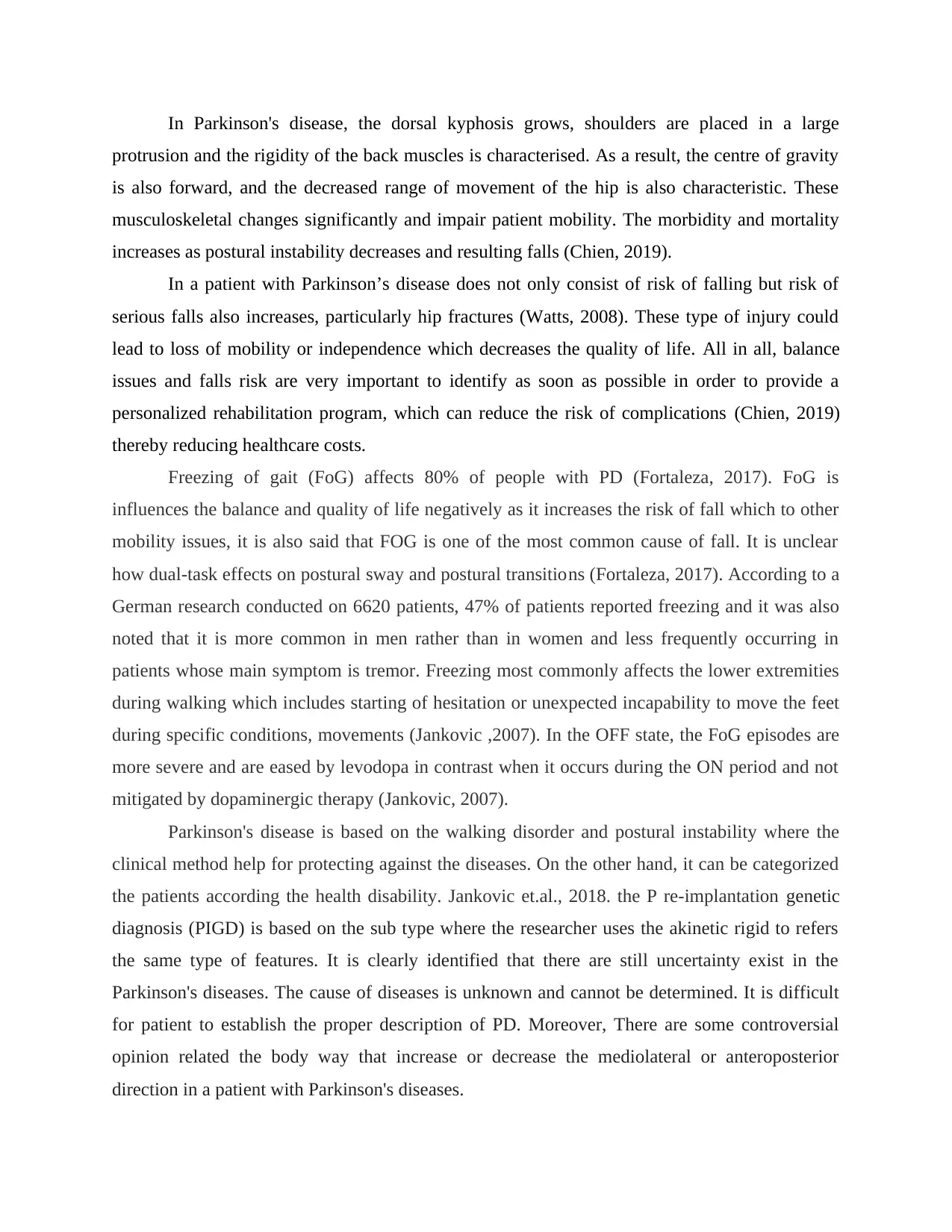
In Parkinson's disease, the dorsal kyphosis grows, shoulders are placed in a large
protrusion and the rigidity of the back muscles is characterised. As a result, the centre of gravity
is also forward, and the decreased range of movement of the hip is also characteristic. These
musculoskeletal changes significantly and impair patient mobility. The morbidity and mortality
increases as postural instability decreases and resulting falls (Chien, 2019).
In a patient with Parkinson’s disease does not only consist of risk of falling but risk of
serious falls also increases, particularly hip fractures (Watts, 2008). These type of injury could
lead to loss of mobility or independence which decreases the quality of life. All in all, balance
issues and falls risk are very important to identify as soon as possible in order to provide a
personalized rehabilitation program, which can reduce the risk of complications (Chien, 2019)
thereby reducing healthcare costs.
Freezing of gait (FoG) affects 80% of people with PD (Fortaleza, 2017). FoG is
influences the balance and quality of life negatively as it increases the risk of fall which to other
mobility issues, it is also said that FOG is one of the most common cause of fall. It is unclear
how dual-task effects on postural sway and postural transitions (Fortaleza, 2017). According to a
German research conducted on 6620 patients, 47% of patients reported freezing and it was also
noted that it is more common in men rather than in women and less frequently occurring in
patients whose main symptom is tremor. Freezing most commonly affects the lower extremities
during walking which includes starting of hesitation or unexpected incapability to move the feet
during specific conditions, movements (Jankovic ,2007). In the OFF state, the FoG episodes are
more severe and are eased by levodopa in contrast when it occurs during the ON period and not
mitigated by dopaminergic therapy (Jankovic, 2007).
Parkinson's disease is based on the walking disorder and postural instability where the
clinical method help for protecting against the diseases. On the other hand, it can be categorized
the patients according the health disability. Jankovic et.al., 2018. the P re-implantation genetic
diagnosis (PIGD) is based on the sub type where the researcher uses the akinetic rigid to refers
the same type of features. It is clearly identified that there are still uncertainty exist in the
Parkinson's diseases. The cause of diseases is unknown and cannot be determined. It is difficult
for patient to establish the proper description of PD. Moreover, There are some controversial
opinion related the body way that increase or decrease the mediolateral or anteroposterior
direction in a patient with Parkinson's diseases.
protrusion and the rigidity of the back muscles is characterised. As a result, the centre of gravity
is also forward, and the decreased range of movement of the hip is also characteristic. These
musculoskeletal changes significantly and impair patient mobility. The morbidity and mortality
increases as postural instability decreases and resulting falls (Chien, 2019).
In a patient with Parkinson’s disease does not only consist of risk of falling but risk of
serious falls also increases, particularly hip fractures (Watts, 2008). These type of injury could
lead to loss of mobility or independence which decreases the quality of life. All in all, balance
issues and falls risk are very important to identify as soon as possible in order to provide a
personalized rehabilitation program, which can reduce the risk of complications (Chien, 2019)
thereby reducing healthcare costs.
Freezing of gait (FoG) affects 80% of people with PD (Fortaleza, 2017). FoG is
influences the balance and quality of life negatively as it increases the risk of fall which to other
mobility issues, it is also said that FOG is one of the most common cause of fall. It is unclear
how dual-task effects on postural sway and postural transitions (Fortaleza, 2017). According to a
German research conducted on 6620 patients, 47% of patients reported freezing and it was also
noted that it is more common in men rather than in women and less frequently occurring in
patients whose main symptom is tremor. Freezing most commonly affects the lower extremities
during walking which includes starting of hesitation or unexpected incapability to move the feet
during specific conditions, movements (Jankovic ,2007). In the OFF state, the FoG episodes are
more severe and are eased by levodopa in contrast when it occurs during the ON period and not
mitigated by dopaminergic therapy (Jankovic, 2007).
Parkinson's disease is based on the walking disorder and postural instability where the
clinical method help for protecting against the diseases. On the other hand, it can be categorized
the patients according the health disability. Jankovic et.al., 2018. the P re-implantation genetic
diagnosis (PIGD) is based on the sub type where the researcher uses the akinetic rigid to refers
the same type of features. It is clearly identified that there are still uncertainty exist in the
Parkinson's diseases. The cause of diseases is unknown and cannot be determined. It is difficult
for patient to establish the proper description of PD. Moreover, There are some controversial
opinion related the body way that increase or decrease the mediolateral or anteroposterior
direction in a patient with Parkinson's diseases.
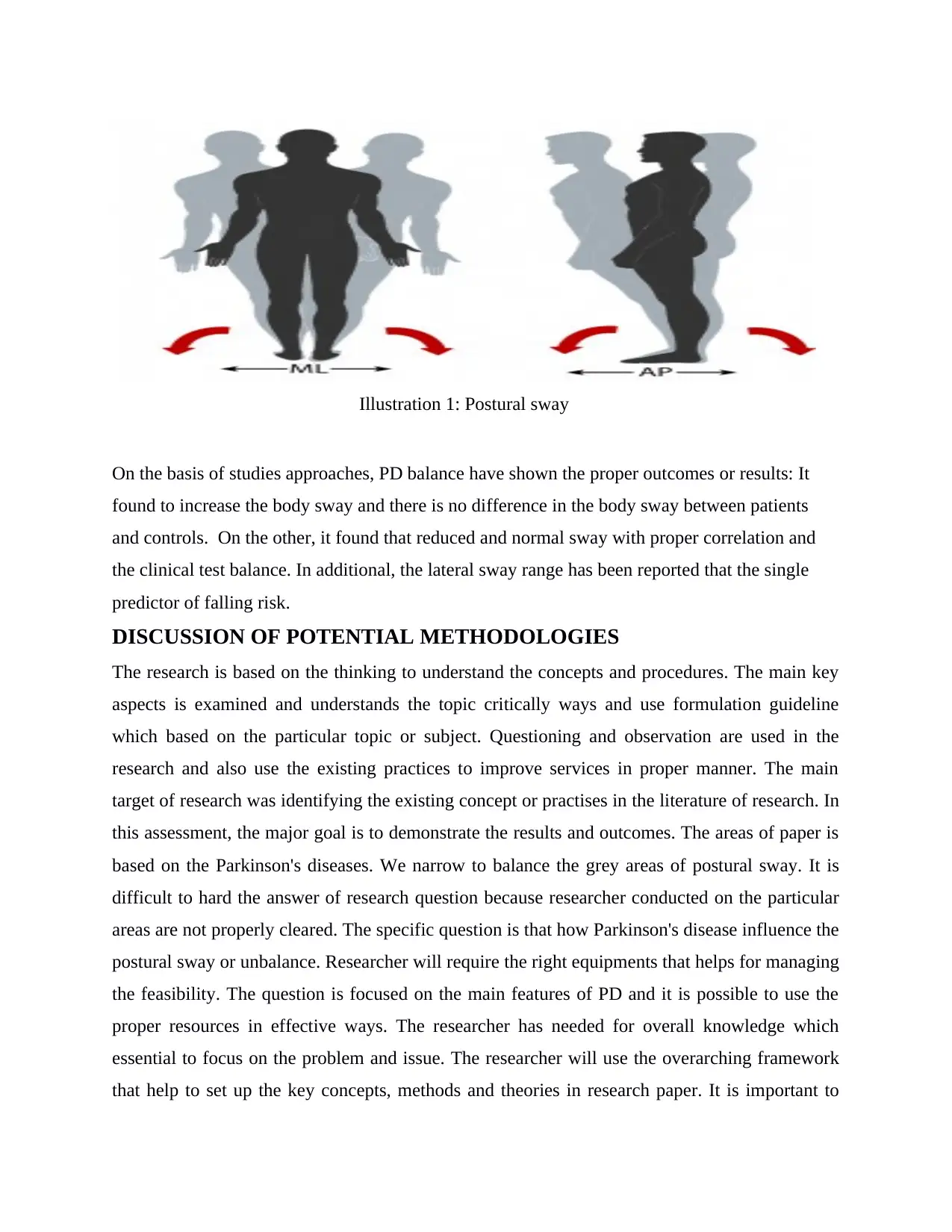
Illustration 1: Postural sway
On the basis of studies approaches, PD balance have shown the proper outcomes or results: It
found to increase the body sway and there is no difference in the body sway between patients
and controls. On the other, it found that reduced and normal sway with proper correlation and
the clinical test balance. In additional, the lateral sway range has been reported that the single
predictor of falling risk.
DISCUSSION OF POTENTIAL METHODOLOGIES
The research is based on the thinking to understand the concepts and procedures. The main key
aspects is examined and understands the topic critically ways and use formulation guideline
which based on the particular topic or subject. Questioning and observation are used in the
research and also use the existing practices to improve services in proper manner. The main
target of research was identifying the existing concept or practises in the literature of research. In
this assessment, the major goal is to demonstrate the results and outcomes. The areas of paper is
based on the Parkinson's diseases. We narrow to balance the grey areas of postural sway. It is
difficult to hard the answer of research question because researcher conducted on the particular
areas are not properly cleared. The specific question is that how Parkinson's disease influence the
postural sway or unbalance. Researcher will require the right equipments that helps for managing
the feasibility. The question is focused on the main features of PD and it is possible to use the
proper resources in effective ways. The researcher has needed for overall knowledge which
essential to focus on the problem and issue. The researcher will use the overarching framework
that help to set up the key concepts, methods and theories in research paper. It is important to
On the basis of studies approaches, PD balance have shown the proper outcomes or results: It
found to increase the body sway and there is no difference in the body sway between patients
and controls. On the other, it found that reduced and normal sway with proper correlation and
the clinical test balance. In additional, the lateral sway range has been reported that the single
predictor of falling risk.
DISCUSSION OF POTENTIAL METHODOLOGIES
The research is based on the thinking to understand the concepts and procedures. The main key
aspects is examined and understands the topic critically ways and use formulation guideline
which based on the particular topic or subject. Questioning and observation are used in the
research and also use the existing practices to improve services in proper manner. The main
target of research was identifying the existing concept or practises in the literature of research. In
this assessment, the major goal is to demonstrate the results and outcomes. The areas of paper is
based on the Parkinson's diseases. We narrow to balance the grey areas of postural sway. It is
difficult to hard the answer of research question because researcher conducted on the particular
areas are not properly cleared. The specific question is that how Parkinson's disease influence the
postural sway or unbalance. Researcher will require the right equipments that helps for managing
the feasibility. The question is focused on the main features of PD and it is possible to use the
proper resources in effective ways. The researcher has needed for overall knowledge which
essential to focus on the problem and issue. The researcher will use the overarching framework
that help to set up the key concepts, methods and theories in research paper. It is important to
⊘ This is a preview!⊘
Do you want full access?
Subscribe today to unlock all pages.

Trusted by 1+ million students worldwide
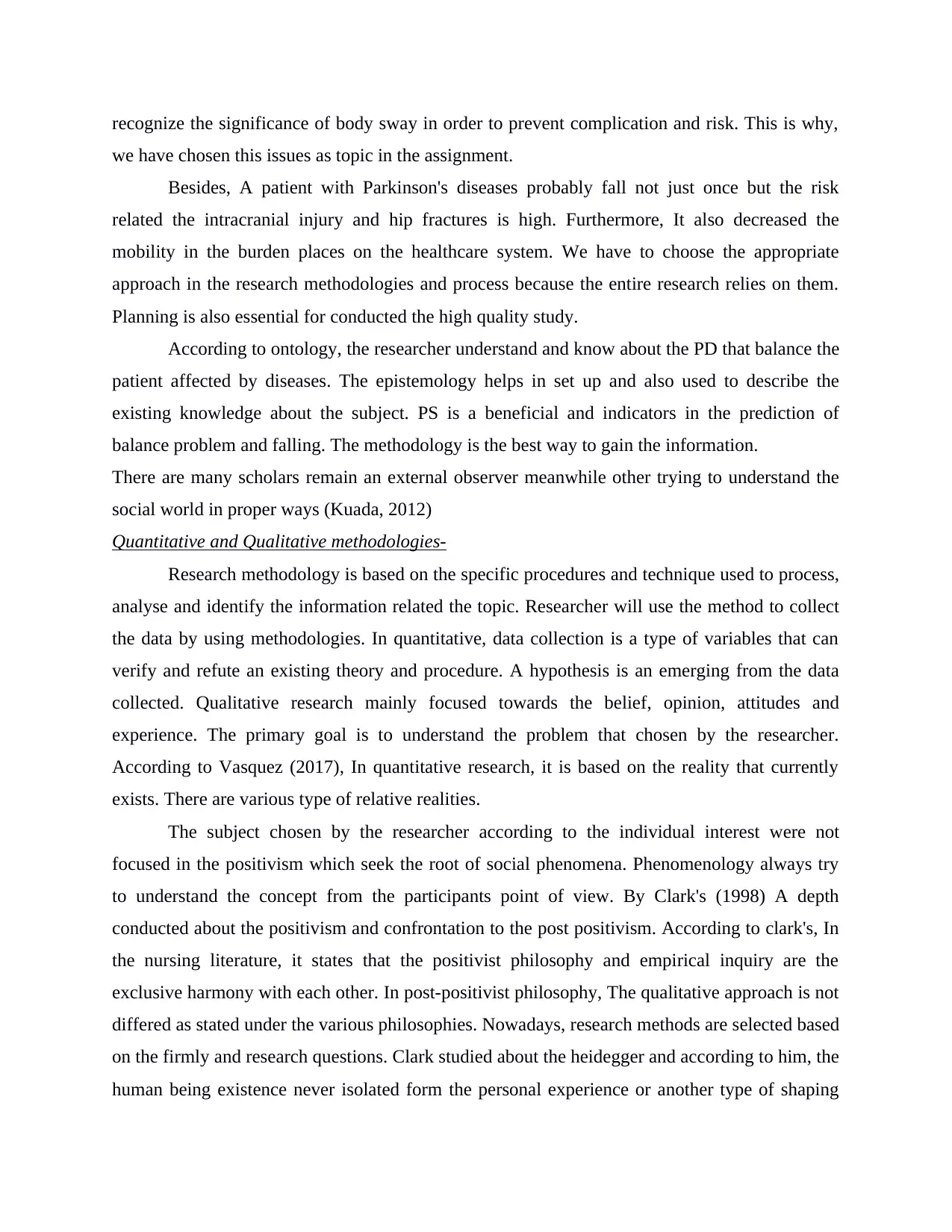
recognize the significance of body sway in order to prevent complication and risk. This is why,
we have chosen this issues as topic in the assignment.
Besides, A patient with Parkinson's diseases probably fall not just once but the risk
related the intracranial injury and hip fractures is high. Furthermore, It also decreased the
mobility in the burden places on the healthcare system. We have to choose the appropriate
approach in the research methodologies and process because the entire research relies on them.
Planning is also essential for conducted the high quality study.
According to ontology, the researcher understand and know about the PD that balance the
patient affected by diseases. The epistemology helps in set up and also used to describe the
existing knowledge about the subject. PS is a beneficial and indicators in the prediction of
balance problem and falling. The methodology is the best way to gain the information.
There are many scholars remain an external observer meanwhile other trying to understand the
social world in proper ways (Kuada, 2012)
Quantitative and Qualitative methodologies-
Research methodology is based on the specific procedures and technique used to process,
analyse and identify the information related the topic. Researcher will use the method to collect
the data by using methodologies. In quantitative, data collection is a type of variables that can
verify and refute an existing theory and procedure. A hypothesis is an emerging from the data
collected. Qualitative research mainly focused towards the belief, opinion, attitudes and
experience. The primary goal is to understand the problem that chosen by the researcher.
According to Vasquez (2017), In quantitative research, it is based on the reality that currently
exists. There are various type of relative realities.
The subject chosen by the researcher according to the individual interest were not
focused in the positivism which seek the root of social phenomena. Phenomenology always try
to understand the concept from the participants point of view. By Clark's (1998) A depth
conducted about the positivism and confrontation to the post positivism. According to clark's, In
the nursing literature, it states that the positivist philosophy and empirical inquiry are the
exclusive harmony with each other. In post-positivist philosophy, The qualitative approach is not
differed as stated under the various philosophies. Nowadays, research methods are selected based
on the firmly and research questions. Clark studied about the heidegger and according to him, the
human being existence never isolated form the personal experience or another type of shaping
we have chosen this issues as topic in the assignment.
Besides, A patient with Parkinson's diseases probably fall not just once but the risk
related the intracranial injury and hip fractures is high. Furthermore, It also decreased the
mobility in the burden places on the healthcare system. We have to choose the appropriate
approach in the research methodologies and process because the entire research relies on them.
Planning is also essential for conducted the high quality study.
According to ontology, the researcher understand and know about the PD that balance the
patient affected by diseases. The epistemology helps in set up and also used to describe the
existing knowledge about the subject. PS is a beneficial and indicators in the prediction of
balance problem and falling. The methodology is the best way to gain the information.
There are many scholars remain an external observer meanwhile other trying to understand the
social world in proper ways (Kuada, 2012)
Quantitative and Qualitative methodologies-
Research methodology is based on the specific procedures and technique used to process,
analyse and identify the information related the topic. Researcher will use the method to collect
the data by using methodologies. In quantitative, data collection is a type of variables that can
verify and refute an existing theory and procedure. A hypothesis is an emerging from the data
collected. Qualitative research mainly focused towards the belief, opinion, attitudes and
experience. The primary goal is to understand the problem that chosen by the researcher.
According to Vasquez (2017), In quantitative research, it is based on the reality that currently
exists. There are various type of relative realities.
The subject chosen by the researcher according to the individual interest were not
focused in the positivism which seek the root of social phenomena. Phenomenology always try
to understand the concept from the participants point of view. By Clark's (1998) A depth
conducted about the positivism and confrontation to the post positivism. According to clark's, In
the nursing literature, it states that the positivist philosophy and empirical inquiry are the
exclusive harmony with each other. In post-positivist philosophy, The qualitative approach is not
differed as stated under the various philosophies. Nowadays, research methods are selected based
on the firmly and research questions. Clark studied about the heidegger and according to him, the
human being existence never isolated form the personal experience or another type of shaping
Paraphrase This Document
Need a fresh take? Get an instant paraphrase of this document with our AI Paraphraser
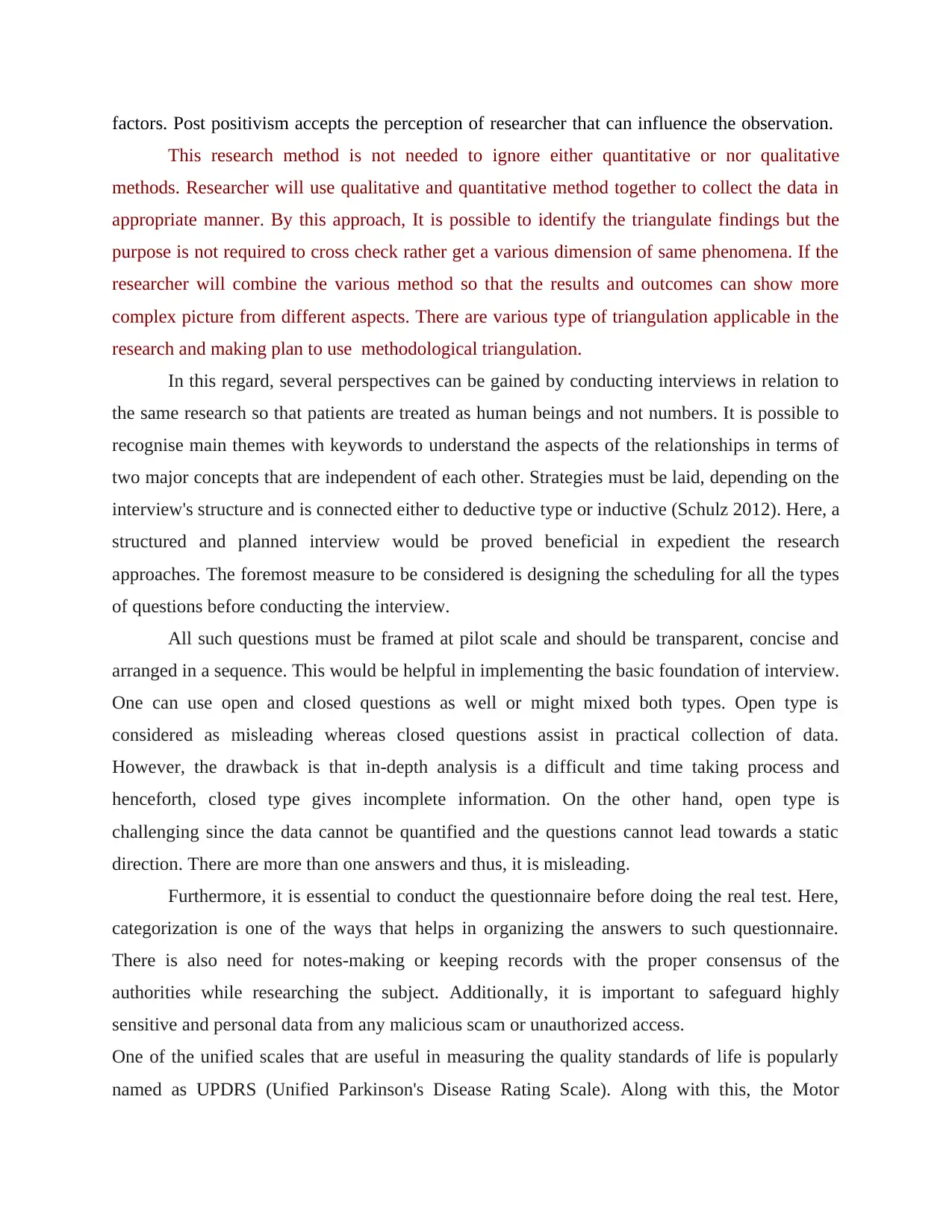
factors. Post positivism accepts the perception of researcher that can influence the observation.
This research method is not needed to ignore either quantitative or nor qualitative
methods. Researcher will use qualitative and quantitative method together to collect the data in
appropriate manner. By this approach, It is possible to identify the triangulate findings but the
purpose is not required to cross check rather get a various dimension of same phenomena. If the
researcher will combine the various method so that the results and outcomes can show more
complex picture from different aspects. There are various type of triangulation applicable in the
research and making plan to use methodological triangulation.
In this regard, several perspectives can be gained by conducting interviews in relation to
the same research so that patients are treated as human beings and not numbers. It is possible to
recognise main themes with keywords to understand the aspects of the relationships in terms of
two major concepts that are independent of each other. Strategies must be laid, depending on the
interview's structure and is connected either to deductive type or inductive (Schulz 2012). Here, a
structured and planned interview would be proved beneficial in expedient the research
approaches. The foremost measure to be considered is designing the scheduling for all the types
of questions before conducting the interview.
All such questions must be framed at pilot scale and should be transparent, concise and
arranged in a sequence. This would be helpful in implementing the basic foundation of interview.
One can use open and closed questions as well or might mixed both types. Open type is
considered as misleading whereas closed questions assist in practical collection of data.
However, the drawback is that in-depth analysis is a difficult and time taking process and
henceforth, closed type gives incomplete information. On the other hand, open type is
challenging since the data cannot be quantified and the questions cannot lead towards a static
direction. There are more than one answers and thus, it is misleading.
Furthermore, it is essential to conduct the questionnaire before doing the real test. Here,
categorization is one of the ways that helps in organizing the answers to such questionnaire.
There is also need for notes-making or keeping records with the proper consensus of the
authorities while researching the subject. Additionally, it is important to safeguard highly
sensitive and personal data from any malicious scam or unauthorized access.
One of the unified scales that are useful in measuring the quality standards of life is popularly
named as UPDRS (Unified Parkinson's Disease Rating Scale). Along with this, the Motor
This research method is not needed to ignore either quantitative or nor qualitative
methods. Researcher will use qualitative and quantitative method together to collect the data in
appropriate manner. By this approach, It is possible to identify the triangulate findings but the
purpose is not required to cross check rather get a various dimension of same phenomena. If the
researcher will combine the various method so that the results and outcomes can show more
complex picture from different aspects. There are various type of triangulation applicable in the
research and making plan to use methodological triangulation.
In this regard, several perspectives can be gained by conducting interviews in relation to
the same research so that patients are treated as human beings and not numbers. It is possible to
recognise main themes with keywords to understand the aspects of the relationships in terms of
two major concepts that are independent of each other. Strategies must be laid, depending on the
interview's structure and is connected either to deductive type or inductive (Schulz 2012). Here, a
structured and planned interview would be proved beneficial in expedient the research
approaches. The foremost measure to be considered is designing the scheduling for all the types
of questions before conducting the interview.
All such questions must be framed at pilot scale and should be transparent, concise and
arranged in a sequence. This would be helpful in implementing the basic foundation of interview.
One can use open and closed questions as well or might mixed both types. Open type is
considered as misleading whereas closed questions assist in practical collection of data.
However, the drawback is that in-depth analysis is a difficult and time taking process and
henceforth, closed type gives incomplete information. On the other hand, open type is
challenging since the data cannot be quantified and the questions cannot lead towards a static
direction. There are more than one answers and thus, it is misleading.
Furthermore, it is essential to conduct the questionnaire before doing the real test. Here,
categorization is one of the ways that helps in organizing the answers to such questionnaire.
There is also need for notes-making or keeping records with the proper consensus of the
authorities while researching the subject. Additionally, it is important to safeguard highly
sensitive and personal data from any malicious scam or unauthorized access.
One of the unified scales that are useful in measuring the quality standards of life is popularly
named as UPDRS (Unified Parkinson's Disease Rating Scale). Along with this, the Motor

Section III that has been defined in this scale and is termed as MDS-UPDRS has been proved
effective and reachable in the overall measurements of mobility. This part in the third section is
mainly dealing with 23 questions which are in direct relations with tremor, rigidity,gait,
bradykinesia and more (Fortaleza 2017). Thus, interviews and UPDRS acted important for
collecting the subjective data. Additionally, hypotheses has been built up with the help of using
deductive research proposal by adopting profound observatory skills to bring authenticity and a
confirmation to ideas. However, relationships can be found from the view of patients and
quantitative research methodology can be used to labelled as quantitative research methodology.
Additionally, there was also implementation of positivism or experimental methodology. This
laid the foundation for the researcher to remain independent and detached as well. Thus, the
measurements that were done proved to be more objective.
Frenklach et al. explored the relationship between the risk of fall and the postural sway
at various steps involved in PD. Here, the Postural instability in PD direct towards the falls and
the postural control system helped in keeping the centre of gravity (CoG) in lines with the
gravitational vertical. This system has the ability to widen the range of sway which depends on
the dimensional support base. If this postural sway exceeds the limits of stability the risk of
falling then it indicates that postural sway may be a good indicator of the risk of falling. Here,
the change in Position would be more dangerous due to the increased likelihood of falling and
even standing might be challenging in the advanced stages of PD, as the CoG tends to move too
posterior.
In the study, total patients who participated were 102 at different stages of participated
and were divided into subgroups including the PD subjects which are never-treated and on very
early stage. 9 other participants with PD who have never been treated with dopaminergic
medication but had a UPDRS III>20 have been also included in this study under moderate-
advanced stage PD group. The Researchers metered OFF medication state subjects with SOT of
computerized dynamic posturography. They compared the data with control group, who were
age-matched healthy subjects. A Student’s t-test was used to determine differences between the
groups. It had been shown in the results that there were no significant differences in equilibrium
scores between the groups with PD and the control subjects. However, moderate-advanced stage
PD group showed significant greater values for all SOT conditions.
effective and reachable in the overall measurements of mobility. This part in the third section is
mainly dealing with 23 questions which are in direct relations with tremor, rigidity,gait,
bradykinesia and more (Fortaleza 2017). Thus, interviews and UPDRS acted important for
collecting the subjective data. Additionally, hypotheses has been built up with the help of using
deductive research proposal by adopting profound observatory skills to bring authenticity and a
confirmation to ideas. However, relationships can be found from the view of patients and
quantitative research methodology can be used to labelled as quantitative research methodology.
Additionally, there was also implementation of positivism or experimental methodology. This
laid the foundation for the researcher to remain independent and detached as well. Thus, the
measurements that were done proved to be more objective.
Frenklach et al. explored the relationship between the risk of fall and the postural sway
at various steps involved in PD. Here, the Postural instability in PD direct towards the falls and
the postural control system helped in keeping the centre of gravity (CoG) in lines with the
gravitational vertical. This system has the ability to widen the range of sway which depends on
the dimensional support base. If this postural sway exceeds the limits of stability the risk of
falling then it indicates that postural sway may be a good indicator of the risk of falling. Here,
the change in Position would be more dangerous due to the increased likelihood of falling and
even standing might be challenging in the advanced stages of PD, as the CoG tends to move too
posterior.
In the study, total patients who participated were 102 at different stages of participated
and were divided into subgroups including the PD subjects which are never-treated and on very
early stage. 9 other participants with PD who have never been treated with dopaminergic
medication but had a UPDRS III>20 have been also included in this study under moderate-
advanced stage PD group. The Researchers metered OFF medication state subjects with SOT of
computerized dynamic posturography. They compared the data with control group, who were
age-matched healthy subjects. A Student’s t-test was used to determine differences between the
groups. It had been shown in the results that there were no significant differences in equilibrium
scores between the groups with PD and the control subjects. However, moderate-advanced stage
PD group showed significant greater values for all SOT conditions.
⊘ This is a preview!⊘
Do you want full access?
Subscribe today to unlock all pages.

Trusted by 1+ million students worldwide
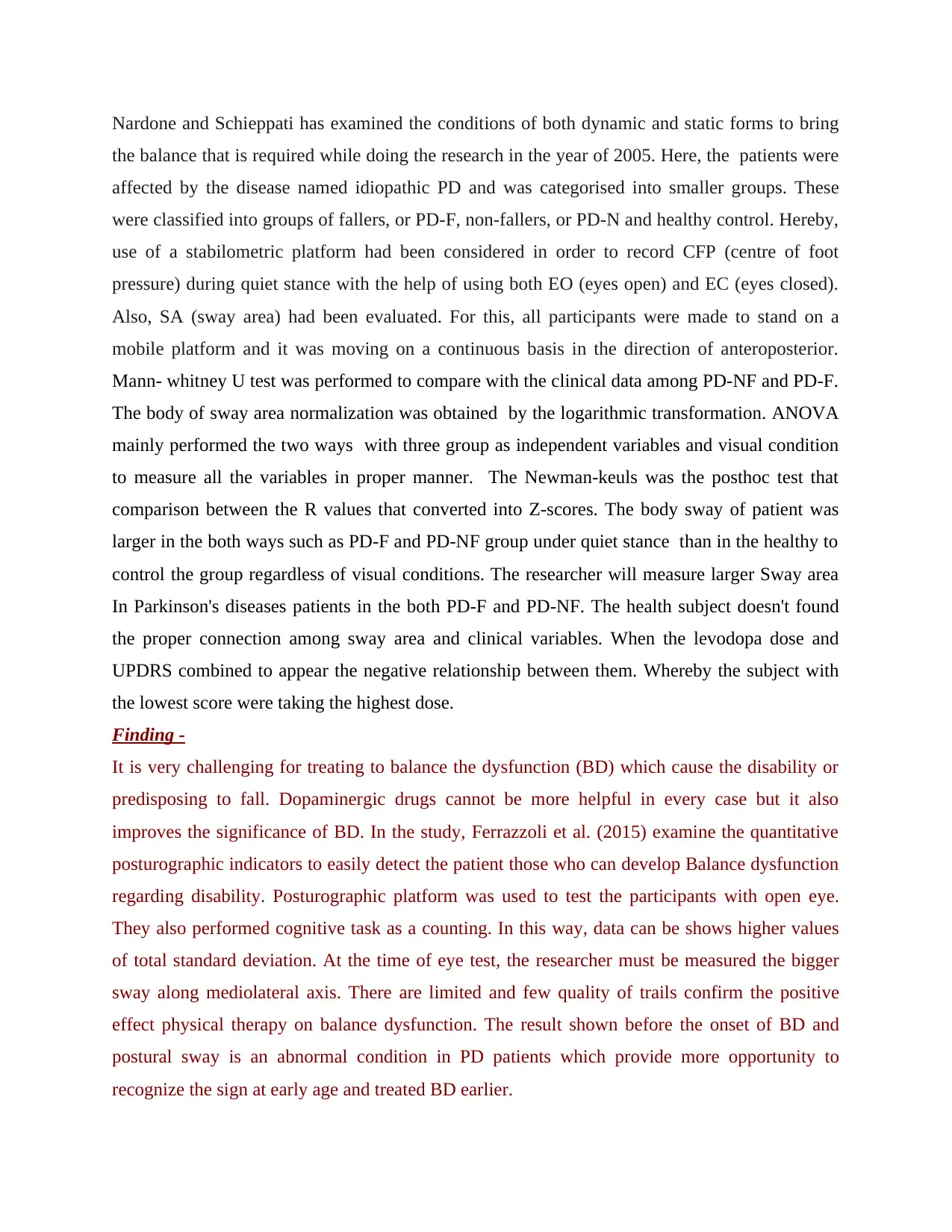
Nardone and Schieppati has examined the conditions of both dynamic and static forms to bring
the balance that is required while doing the research in the year of 2005. Here, the patients were
affected by the disease named idiopathic PD and was categorised into smaller groups. These
were classified into groups of fallers, or PD-F, non-fallers, or PD-N and healthy control. Hereby,
use of a stabilometric platform had been considered in order to record CFP (centre of foot
pressure) during quiet stance with the help of using both EO (eyes open) and EC (eyes closed).
Also, SA (sway area) had been evaluated. For this, all participants were made to stand on a
mobile platform and it was moving on a continuous basis in the direction of anteroposterior.
Mann- whitney U test was performed to compare with the clinical data among PD-NF and PD-F.
The body of sway area normalization was obtained by the logarithmic transformation. ANOVA
mainly performed the two ways with three group as independent variables and visual condition
to measure all the variables in proper manner. The Newman-keuls was the posthoc test that
comparison between the R values that converted into Z-scores. The body sway of patient was
larger in the both ways such as PD-F and PD-NF group under quiet stance than in the healthy to
control the group regardless of visual conditions. The researcher will measure larger Sway area
In Parkinson's diseases patients in the both PD-F and PD-NF. The health subject doesn't found
the proper connection among sway area and clinical variables. When the levodopa dose and
UPDRS combined to appear the negative relationship between them. Whereby the subject with
the lowest score were taking the highest dose.
Finding -
It is very challenging for treating to balance the dysfunction (BD) which cause the disability or
predisposing to fall. Dopaminergic drugs cannot be more helpful in every case but it also
improves the significance of BD. In the study, Ferrazzoli et al. (2015) examine the quantitative
posturographic indicators to easily detect the patient those who can develop Balance dysfunction
regarding disability. Posturographic platform was used to test the participants with open eye.
They also performed cognitive task as a counting. In this way, data can be shows higher values
of total standard deviation. At the time of eye test, the researcher must be measured the bigger
sway along mediolateral axis. There are limited and few quality of trails confirm the positive
effect physical therapy on balance dysfunction. The result shown before the onset of BD and
postural sway is an abnormal condition in PD patients which provide more opportunity to
recognize the sign at early age and treated BD earlier.
the balance that is required while doing the research in the year of 2005. Here, the patients were
affected by the disease named idiopathic PD and was categorised into smaller groups. These
were classified into groups of fallers, or PD-F, non-fallers, or PD-N and healthy control. Hereby,
use of a stabilometric platform had been considered in order to record CFP (centre of foot
pressure) during quiet stance with the help of using both EO (eyes open) and EC (eyes closed).
Also, SA (sway area) had been evaluated. For this, all participants were made to stand on a
mobile platform and it was moving on a continuous basis in the direction of anteroposterior.
Mann- whitney U test was performed to compare with the clinical data among PD-NF and PD-F.
The body of sway area normalization was obtained by the logarithmic transformation. ANOVA
mainly performed the two ways with three group as independent variables and visual condition
to measure all the variables in proper manner. The Newman-keuls was the posthoc test that
comparison between the R values that converted into Z-scores. The body sway of patient was
larger in the both ways such as PD-F and PD-NF group under quiet stance than in the healthy to
control the group regardless of visual conditions. The researcher will measure larger Sway area
In Parkinson's diseases patients in the both PD-F and PD-NF. The health subject doesn't found
the proper connection among sway area and clinical variables. When the levodopa dose and
UPDRS combined to appear the negative relationship between them. Whereby the subject with
the lowest score were taking the highest dose.
Finding -
It is very challenging for treating to balance the dysfunction (BD) which cause the disability or
predisposing to fall. Dopaminergic drugs cannot be more helpful in every case but it also
improves the significance of BD. In the study, Ferrazzoli et al. (2015) examine the quantitative
posturographic indicators to easily detect the patient those who can develop Balance dysfunction
regarding disability. Posturographic platform was used to test the participants with open eye.
They also performed cognitive task as a counting. In this way, data can be shows higher values
of total standard deviation. At the time of eye test, the researcher must be measured the bigger
sway along mediolateral axis. There are limited and few quality of trails confirm the positive
effect physical therapy on balance dysfunction. The result shown before the onset of BD and
postural sway is an abnormal condition in PD patients which provide more opportunity to
recognize the sign at early age and treated BD earlier.
Paraphrase This Document
Need a fresh take? Get an instant paraphrase of this document with our AI Paraphraser
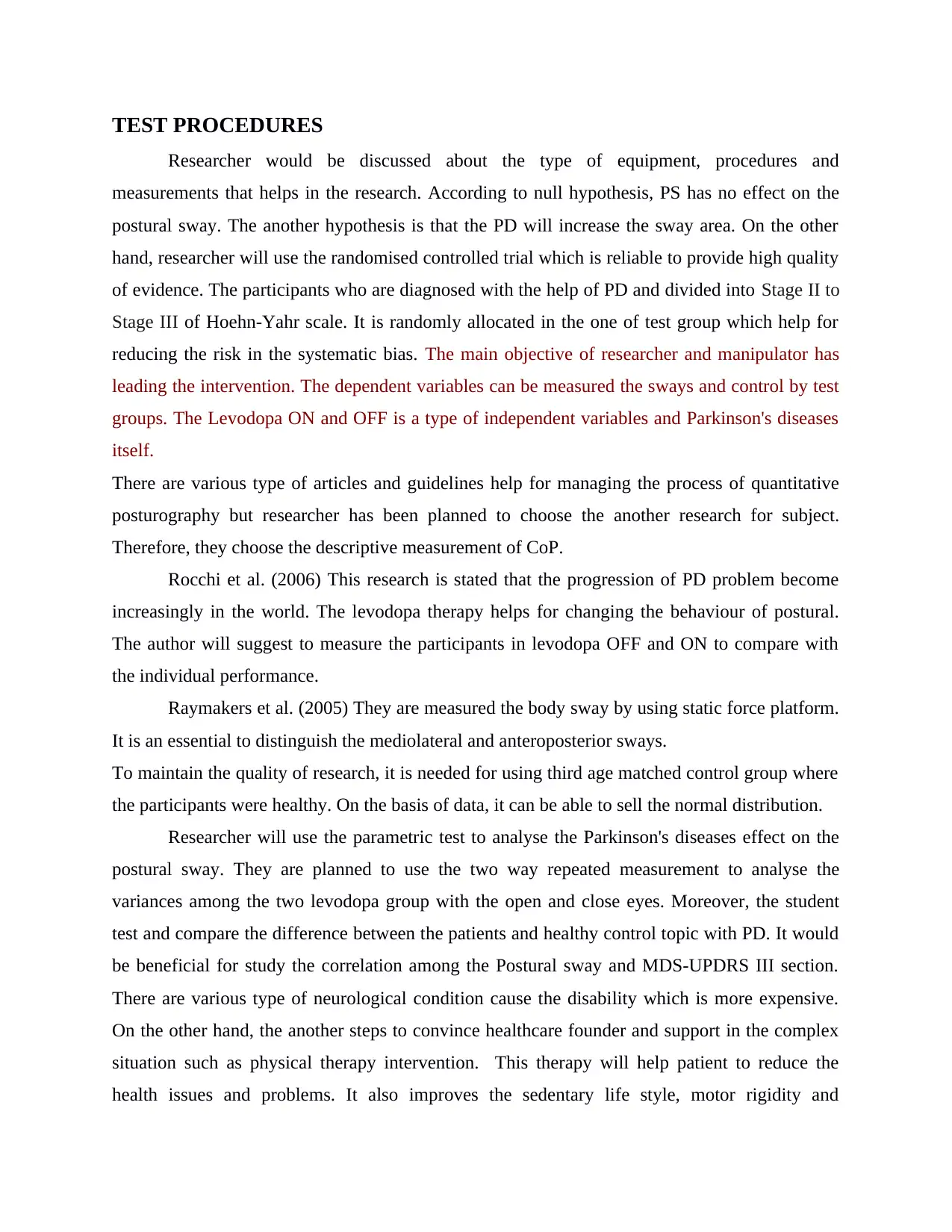
TEST PROCEDURES
Researcher would be discussed about the type of equipment, procedures and
measurements that helps in the research. According to null hypothesis, PS has no effect on the
postural sway. The another hypothesis is that the PD will increase the sway area. On the other
hand, researcher will use the randomised controlled trial which is reliable to provide high quality
of evidence. The participants who are diagnosed with the help of PD and divided into Stage II to
Stage III of Hoehn-Yahr scale. It is randomly allocated in the one of test group which help for
reducing the risk in the systematic bias. The main objective of researcher and manipulator has
leading the intervention. The dependent variables can be measured the sways and control by test
groups. The Levodopa ON and OFF is a type of independent variables and Parkinson's diseases
itself.
There are various type of articles and guidelines help for managing the process of quantitative
posturography but researcher has been planned to choose the another research for subject.
Therefore, they choose the descriptive measurement of CoP.
Rocchi et al. (2006) This research is stated that the progression of PD problem become
increasingly in the world. The levodopa therapy helps for changing the behaviour of postural.
The author will suggest to measure the participants in levodopa OFF and ON to compare with
the individual performance.
Raymakers et al. (2005) They are measured the body sway by using static force platform.
It is an essential to distinguish the mediolateral and anteroposterior sways.
To maintain the quality of research, it is needed for using third age matched control group where
the participants were healthy. On the basis of data, it can be able to sell the normal distribution.
Researcher will use the parametric test to analyse the Parkinson's diseases effect on the
postural sway. They are planned to use the two way repeated measurement to analyse the
variances among the two levodopa group with the open and close eyes. Moreover, the student
test and compare the difference between the patients and healthy control topic with PD. It would
be beneficial for study the correlation among the Postural sway and MDS-UPDRS III section.
There are various type of neurological condition cause the disability which is more expensive.
On the other hand, the another steps to convince healthcare founder and support in the complex
situation such as physical therapy intervention. This therapy will help patient to reduce the
health issues and problems. It also improves the sedentary life style, motor rigidity and
Researcher would be discussed about the type of equipment, procedures and
measurements that helps in the research. According to null hypothesis, PS has no effect on the
postural sway. The another hypothesis is that the PD will increase the sway area. On the other
hand, researcher will use the randomised controlled trial which is reliable to provide high quality
of evidence. The participants who are diagnosed with the help of PD and divided into Stage II to
Stage III of Hoehn-Yahr scale. It is randomly allocated in the one of test group which help for
reducing the risk in the systematic bias. The main objective of researcher and manipulator has
leading the intervention. The dependent variables can be measured the sways and control by test
groups. The Levodopa ON and OFF is a type of independent variables and Parkinson's diseases
itself.
There are various type of articles and guidelines help for managing the process of quantitative
posturography but researcher has been planned to choose the another research for subject.
Therefore, they choose the descriptive measurement of CoP.
Rocchi et al. (2006) This research is stated that the progression of PD problem become
increasingly in the world. The levodopa therapy helps for changing the behaviour of postural.
The author will suggest to measure the participants in levodopa OFF and ON to compare with
the individual performance.
Raymakers et al. (2005) They are measured the body sway by using static force platform.
It is an essential to distinguish the mediolateral and anteroposterior sways.
To maintain the quality of research, it is needed for using third age matched control group where
the participants were healthy. On the basis of data, it can be able to sell the normal distribution.
Researcher will use the parametric test to analyse the Parkinson's diseases effect on the
postural sway. They are planned to use the two way repeated measurement to analyse the
variances among the two levodopa group with the open and close eyes. Moreover, the student
test and compare the difference between the patients and healthy control topic with PD. It would
be beneficial for study the correlation among the Postural sway and MDS-UPDRS III section.
There are various type of neurological condition cause the disability which is more expensive.
On the other hand, the another steps to convince healthcare founder and support in the complex
situation such as physical therapy intervention. This therapy will help patient to reduce the
health issues and problems. It also improves the sedentary life style, motor rigidity and
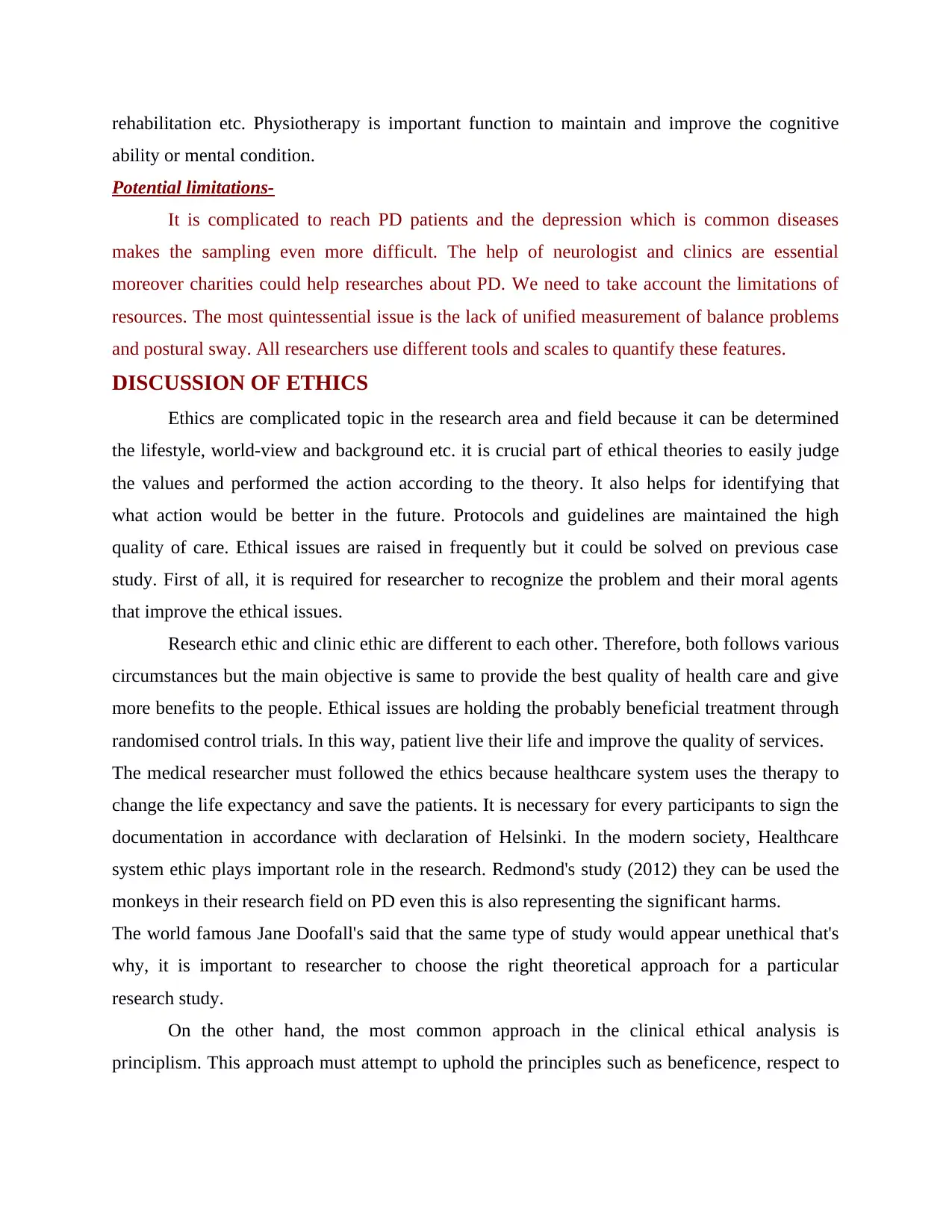
rehabilitation etc. Physiotherapy is important function to maintain and improve the cognitive
ability or mental condition.
Potential limitations-
It is complicated to reach PD patients and the depression which is common diseases
makes the sampling even more difficult. The help of neurologist and clinics are essential
moreover charities could help researches about PD. We need to take account the limitations of
resources. The most quintessential issue is the lack of unified measurement of balance problems
and postural sway. All researchers use different tools and scales to quantify these features.
DISCUSSION OF ETHICS
Ethics are complicated topic in the research area and field because it can be determined
the lifestyle, world-view and background etc. it is crucial part of ethical theories to easily judge
the values and performed the action according to the theory. It also helps for identifying that
what action would be better in the future. Protocols and guidelines are maintained the high
quality of care. Ethical issues are raised in frequently but it could be solved on previous case
study. First of all, it is required for researcher to recognize the problem and their moral agents
that improve the ethical issues.
Research ethic and clinic ethic are different to each other. Therefore, both follows various
circumstances but the main objective is same to provide the best quality of health care and give
more benefits to the people. Ethical issues are holding the probably beneficial treatment through
randomised control trials. In this way, patient live their life and improve the quality of services.
The medical researcher must followed the ethics because healthcare system uses the therapy to
change the life expectancy and save the patients. It is necessary for every participants to sign the
documentation in accordance with declaration of Helsinki. In the modern society, Healthcare
system ethic plays important role in the research. Redmond's study (2012) they can be used the
monkeys in their research field on PD even this is also representing the significant harms.
The world famous Jane Doofall's said that the same type of study would appear unethical that's
why, it is important to researcher to choose the right theoretical approach for a particular
research study.
On the other hand, the most common approach in the clinical ethical analysis is
principlism. This approach must attempt to uphold the principles such as beneficence, respect to
ability or mental condition.
Potential limitations-
It is complicated to reach PD patients and the depression which is common diseases
makes the sampling even more difficult. The help of neurologist and clinics are essential
moreover charities could help researches about PD. We need to take account the limitations of
resources. The most quintessential issue is the lack of unified measurement of balance problems
and postural sway. All researchers use different tools and scales to quantify these features.
DISCUSSION OF ETHICS
Ethics are complicated topic in the research area and field because it can be determined
the lifestyle, world-view and background etc. it is crucial part of ethical theories to easily judge
the values and performed the action according to the theory. It also helps for identifying that
what action would be better in the future. Protocols and guidelines are maintained the high
quality of care. Ethical issues are raised in frequently but it could be solved on previous case
study. First of all, it is required for researcher to recognize the problem and their moral agents
that improve the ethical issues.
Research ethic and clinic ethic are different to each other. Therefore, both follows various
circumstances but the main objective is same to provide the best quality of health care and give
more benefits to the people. Ethical issues are holding the probably beneficial treatment through
randomised control trials. In this way, patient live their life and improve the quality of services.
The medical researcher must followed the ethics because healthcare system uses the therapy to
change the life expectancy and save the patients. It is necessary for every participants to sign the
documentation in accordance with declaration of Helsinki. In the modern society, Healthcare
system ethic plays important role in the research. Redmond's study (2012) they can be used the
monkeys in their research field on PD even this is also representing the significant harms.
The world famous Jane Doofall's said that the same type of study would appear unethical that's
why, it is important to researcher to choose the right theoretical approach for a particular
research study.
On the other hand, the most common approach in the clinical ethical analysis is
principlism. This approach must attempt to uphold the principles such as beneficence, respect to
⊘ This is a preview!⊘
Do you want full access?
Subscribe today to unlock all pages.

Trusted by 1+ million students worldwide
1 out of 18
Your All-in-One AI-Powered Toolkit for Academic Success.
+13062052269
info@desklib.com
Available 24*7 on WhatsApp / Email
![[object Object]](/_next/static/media/star-bottom.7253800d.svg)
Unlock your academic potential
Copyright © 2020–2025 A2Z Services. All Rights Reserved. Developed and managed by ZUCOL.